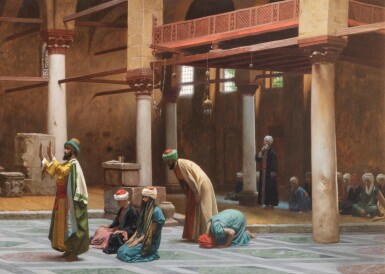Important Works from the Najd Collection
Important Works from the Najd Collection

JEAN-LÉON GÉRÔME | PRAYERS IN THE MOSQUE
Auction Closed
October 22, 05:34 PM GMT
Estimate
1,500,000 - 2,000,000 GBP
Lot Details
Description
JEAN-LÉON GÉRÔME
French
1824 - 1904
PRAYERS IN THE MOSQUE
signed J.L.GEROME. lower left
oil on canvas
66 by 93cm., 26 by 36½in.
We are grateful to Dr Emily M. Weeks for her assistance in cataloguing this work which will be included in her revision of the artist's catalogue raisonné by Gerald M. Ackerman.
Possibly, Knoedler & Co., New York
Mrs Seth E. Thomas, Jr., New York (sale: Parke Bernet Galleries, New York, 26 January 1949, lot 77)
Mr & Mrs Sany, New Jersey (sale: Parke Bernet Galleries, New York, 26 May 1950, lot 379, as Interior of a Mosque)
Maurice Goldblatt, Chicago
Coral Petroleum, Inc., Texas (sale: Sotheby's, New York, 22 May 1985, lot 37)
Mathaf Gallery, London
Purchased from the above
ed. Coral Petroleum, A Near Eastern Adventure, Houston, n.d, n.p, illustrated
Gerald M. Ackerman, The Life and Work of Jean-Léon Gérôme, Paris, 1986, p. 157, illustrated, pp. 294-95, no. 515, catalogued & illustrated (as Prayer in the Mosque [Prière à la mosquée]); p. 141, discussed
Caroline Juler, Najd Collection of Orientalist Paintings, London, 1991, p. 141, discussed; p. 150, catalogued & illustrated
Gerald M. Ackerman, Jean-Léon Gérôme, Monographie révisée, Paris, 2000, pp. 366-67, no. 515, catalogued & illustrated (as Prière à la mosquée, dated 1892)
Gérôme was highly preoccupied with the subject of Muslim prayer and paved the way for later artists such as Ludwig Deutsch and Frederick Arthur Bridgman to explore the theme. Among his early interpretations of the subject, Evening Prayer, Cairo of 1865 (Hamburger Kunsthalle) set worship at the close of day on a rooftop, while perhaps Gérôme's best known scene of indoor worship is Public Prayer in the Mosque of Amr of 1871 (Metropolitan Museum of Art, New York; fig. 1). The architectural setting of that and the present work includes similar elements such as Corinthian capitals with wooden tie beams supporting rounded arches, suggesting a common inspiration in the form of the seventh century Mosque of Amr ibn al-As in Cairo which was one of the many mosques visited by Gérôme during his travels (fig. 2). However, Gérôme’s representation of the actual mosque is quite loose, since windows and a coloured floor appear to be figments of the artist’s imagination.
The present work appears to be the largest of a small series in which Gérôme reinterpreted this setting (see Ackerman 2000, op. cit., pp. 366-367). While in earlier scenes he was unable to resist adorning his figures with richly coloured dress, in these later scenes Gérôme’s men at prayer are noticeably less encumbered with armaments and other trappings.
Orientalist artists almost invariably depict worshippers in a variety of different positions within the same painting, rather than showing the figures in a unified, synchronised movement. In this work Gérôme doubtless wished to show his assumed Western audience the diversity of postures in Muslim prayer, as recorded in Edward William Lane’s influential An Account of the Manners and Customs of the Modern Egyptians (1836). The man at the front of the group raises his hands to recite the Takbir in a particularly striking posture illuminated by the soft light (compare with fig. 3). On the right the man bows to the ground in Sujud, while between them the two men pray the Tashahhud (adding to the improbability, there does not appear to be space in front for these two men to prostrate themselves, although this must have suited Gérôme’s composition). The various abandoned stone blocks in the background are also a puzzling feature within the usually open spaces of a mosque. This tension between the details of the scene, observed with the artist’s near-photographic exactitude, and the more puzzling elements is a hallmark of what has been called Gérôme’s ‘paradox of realism’ (see Sophie Makariou and Charlotte Maury’s essay of that title in The Spectacular Art of Jean-Léon Gérôme, 2010, op. cit.). These fascinating curiosities aside, the respect and seriousness with which Gérôme’s prayer scenes are imbued make these among his most powerful and memorable compositions for the twenty-first century viewer.
